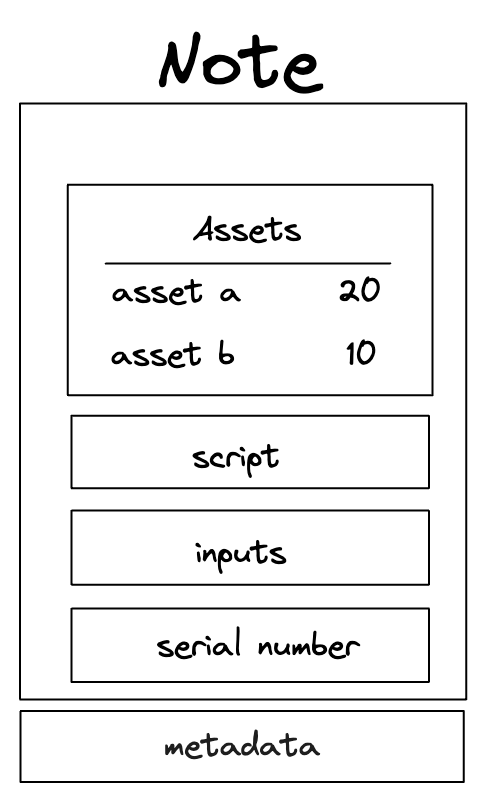Notes and Their Features¶
Notes in Miden are a fundamental component of its hybrid UTXO and account-based state model, designed to enhance both parallel transaction execution and privacy. Unlike Ethereum’s account-based model, Miden’s notes facilitate asset interactions and transfers between accounts asynchronously and privately.

Each note in Miden can contain up to 256 assets, stored in a single hash, and includes a script that defines the conditions for its consumption. This script, executed during the transaction, ensures that the note can only be consumed if specific conditions are met. Additionally, notes have inputs that can be accessed by the note script, a unique serial number to prevent linkability, and metadata such as the sender and note tag, which remain public regardless of the note’s storage mode.
The lifecycle of a note begins with its creation during transaction execution, where it is recorded in the note database. Depending on the note’s privacy setting, the full note data (for public notes), the encrypted note data (for encrypted notes) or just the note hash (for private notes) is stored.
Notes can be produced and consumed locally by users or by the network operator in a transaction. To consume a note, the transacting party must know the note data to compute the nullifier, which, once verified, marks the note as consumed in the nullifier database. This process ensures that notes can be managed efficiently while maintaining the privacy and integrity of transactions within the Miden network.
To learn more about the technical details of notes, you can refer to the Miden technical docs.
Miden’s approach to note efficiency is a key differentiator in the landscape of privacy-focused blockchains by leveraging innovative techniques for note discovery and management.
Efficient Note Discovery¶
One of the standout features of Miden is its efficient note discovery process. Unlike other systems that require decrypting all records to discover private states, Miden uses a tagging mechanism to streamline this process.

Tagging Mechanism¶
In Miden, each note is assigned a tag, which can be used to request notes. This allows users to request a subset of all notes, significantly reducing the amount of data that needs to be processed.

The tagging mechanism introduces some “fuzziness,” meaning users may receive some notes that are not theirs, but this can be controlled to balance privacy and efficiency.
User-Defined Tags¶
Users have the flexibility to choose their tags or use default strategies provided by Miden. For example, a common strategy is to use the first 16 bits of the user’s account ID as a tag. This approach ensures that as the number of accounts grows, the likelihood of tag collisions increases, enhancing privacy through obfuscation.

Requesting Notes¶
Users can request notes by their tags, allowing them to efficiently discover which notes belong to them without downloading all notes. This process is not only efficient but also privacy-preserving, as users can control the rate of false positives and even request all notes if they wish to hide their interests from the node.
Conclusion¶
Miden’s innovative approach to note management and discovery sets it apart in the realm of privacy-focused blockchains. By leveraging public, private, and encrypted notes, along with an efficient tagging mechanism, Miden ensures both privacy and efficiency for its users. This design allows for a seamless and secure user experience, making Miden a compelling choice for privacy-conscious applications.